
Novi prilozi nastajućoj GIF-estetici.
2012. The year of the doomsday apocalypse. The world didn’t end,
though some of us thought it might, and perhaps we even hoped it would,
if only to give us something to look forward to. Žižek, paraphrasing
Jameson, famously said that it’s easier to imagine the end of the world than the end of capitalism—and
this was in a speech given at Zucotti Park during Occupy Wall Street,
in which we tried, and failed, to imagine the beginning of something
else.
But following the natural order of events, as well as what Jameson called “the temporal paradox” (in which history stops but time grinds remorselessly onward in a continuous, cyclical production of “newness”), 2012 came and went and we all kept on doing what we were doing. A perky 25-year-old acronym beat the competition – teeth-grindingly zeitgeisty notables such as YOLO, superstorm and Eurogeddon – to become the Oxford Dictionary’s US Word of the year. You probably know that. What you may not know is that the OUP award went to a verb, rather than a noun: not to the name of a file format, but to the act of making one. To GIF.
To GIF is defined, somewhat redundantly, as “to create a GIF file,” but what would it mean to decouple the verb from its referent? To GIF: to capture a moment on an endless loop.
Now it’s 2013, though nothing has changed. Seeping, soul-level post-Fordism and the precarization of the labor market mean that most of us never stop working: socializing bleeds seamlessly into networking, and meanwhile, each tweet and retweet and Like and click and comment all converge in the production of demographic data. You could say there’s a Sisyphean aspect to life in late Capitalism. Energy drinks and Adderall, cuz sleep is for sissies and the stock market and Internet never sleep at all. An animated GIF never stops cycling silently in the ether, even as your tabs are closed and your laptop shut.
Perhaps in the necessarily entrepreneurial spirit of the new cognitariat, much of the Post-Internet art currently being produced and circulated is visually indistinguishable from the aesthetic language of advertising and corporate branding. The idea that art should be a mirror to life is taken to terrifyingly literal conclusion in gleaming surfaces and brushed chrome effects and knowing selfies in which every artist becomes a cover girl, a stock photography catalogue of white people mugging in streetwear. 50 shades of sexy empty, glistering in flat[-screen] virtuality. So far, so familiar.
The animated GIF, meanwhile—whose origins go back to the antediluvian age of dial-up modems and whose natural home is the resolutely non-artistic bottom-feed of Internet image production—rudely interrupts the unbroken sheen of all the slick shit, since to GIF an image is not only to create a loop, but—in very literal terms pertaining to the effects of LZW compression—to apply a verfremdungseffekt, or distancing effect. The shiny mirror finish of HD video is dithered to dust, dots and dashes, and all the smoothing of Photoshop reduced to a crude cartography of color. The v-effekt was one of political playwright Brecht’s theatrical techniques to ensure an audience never get too comfortable: a device to make the abstract immediate and the political relatable. Here, the distancing effect allows the moving image to circulate widely on low-bandwidth connections, bringing it closer to home. To GIF is to reduce a picture to the “poor image” defended by Hito Steyerl; the conditions of its own circulation made visible. “The poor image is no longer about the real thing—the originary original. Instead, it is about its own real conditions of existence: about swarm circulation, digital dispersion, fractured and flexible temporalities… In short: it is about reality.”
The animated GIF is a Brechtian medium not only in the distancing effects of image compression, but also in that the repetition of a single gesture ad infinitum constitutes a sort of gestus—a symbolic moment that is amplified in context to represent a whole paradigm of existence. Brecht believed that art “is not a mirror held up to reality, but a hammer with which to shape it”—and it is in the attempt to imagine a micromodular, low-cultural political theatre that this series has been curated. I wanted to stop talking about “the work” as though it exists somehow separated from our labor and from our bodies. I wanted to put the body back into the frame, since this is what we learned from OWS and Tahrir: that bodies still signify, no matter how posthuman we might imagine ourselves to be. At a time when social media is a stage and a theater where we're all supposed to play ourselves (each status update a script cue for the spectral self) I wanted to expand the discourse to include artists whose work deals with performance or performativity. Laboring bodies in the spectral ether; from body to bot and back again, and again, and again, and again, and forever and ever, whatever, amen.
JD, LDN 2013 rhizome.org/editorial
But following the natural order of events, as well as what Jameson called “the temporal paradox” (in which history stops but time grinds remorselessly onward in a continuous, cyclical production of “newness”), 2012 came and went and we all kept on doing what we were doing. A perky 25-year-old acronym beat the competition – teeth-grindingly zeitgeisty notables such as YOLO, superstorm and Eurogeddon – to become the Oxford Dictionary’s US Word of the year. You probably know that. What you may not know is that the OUP award went to a verb, rather than a noun: not to the name of a file format, but to the act of making one. To GIF.
To GIF is defined, somewhat redundantly, as “to create a GIF file,” but what would it mean to decouple the verb from its referent? To GIF: to capture a moment on an endless loop.
Now it’s 2013, though nothing has changed. Seeping, soul-level post-Fordism and the precarization of the labor market mean that most of us never stop working: socializing bleeds seamlessly into networking, and meanwhile, each tweet and retweet and Like and click and comment all converge in the production of demographic data. You could say there’s a Sisyphean aspect to life in late Capitalism. Energy drinks and Adderall, cuz sleep is for sissies and the stock market and Internet never sleep at all. An animated GIF never stops cycling silently in the ether, even as your tabs are closed and your laptop shut.
Perhaps in the necessarily entrepreneurial spirit of the new cognitariat, much of the Post-Internet art currently being produced and circulated is visually indistinguishable from the aesthetic language of advertising and corporate branding. The idea that art should be a mirror to life is taken to terrifyingly literal conclusion in gleaming surfaces and brushed chrome effects and knowing selfies in which every artist becomes a cover girl, a stock photography catalogue of white people mugging in streetwear. 50 shades of sexy empty, glistering in flat[-screen] virtuality. So far, so familiar.
The animated GIF, meanwhile—whose origins go back to the antediluvian age of dial-up modems and whose natural home is the resolutely non-artistic bottom-feed of Internet image production—rudely interrupts the unbroken sheen of all the slick shit, since to GIF an image is not only to create a loop, but—in very literal terms pertaining to the effects of LZW compression—to apply a verfremdungseffekt, or distancing effect. The shiny mirror finish of HD video is dithered to dust, dots and dashes, and all the smoothing of Photoshop reduced to a crude cartography of color. The v-effekt was one of political playwright Brecht’s theatrical techniques to ensure an audience never get too comfortable: a device to make the abstract immediate and the political relatable. Here, the distancing effect allows the moving image to circulate widely on low-bandwidth connections, bringing it closer to home. To GIF is to reduce a picture to the “poor image” defended by Hito Steyerl; the conditions of its own circulation made visible. “The poor image is no longer about the real thing—the originary original. Instead, it is about its own real conditions of existence: about swarm circulation, digital dispersion, fractured and flexible temporalities… In short: it is about reality.”
The animated GIF is a Brechtian medium not only in the distancing effects of image compression, but also in that the repetition of a single gesture ad infinitum constitutes a sort of gestus—a symbolic moment that is amplified in context to represent a whole paradigm of existence. Brecht believed that art “is not a mirror held up to reality, but a hammer with which to shape it”—and it is in the attempt to imagine a micromodular, low-cultural political theatre that this series has been curated. I wanted to stop talking about “the work” as though it exists somehow separated from our labor and from our bodies. I wanted to put the body back into the frame, since this is what we learned from OWS and Tahrir: that bodies still signify, no matter how posthuman we might imagine ourselves to be. At a time when social media is a stage and a theater where we're all supposed to play ourselves (each status update a script cue for the spectral self) I wanted to expand the discourse to include artists whose work deals with performance or performativity. Laboring bodies in the spectral ether; from body to bot and back again, and again, and again, and again, and forever and ever, whatever, amen.
JD, LDN 2013 rhizome.org/editorial

Beautiful blue eyes, rosy pink cheeks, plump kissable red lips. A dignified black neck, strong green brow. A black ear. A yellow Adams-apple. I am beautiful. Makeup artist to the stars. Dripping paint. War paint. The mask of the rainbow death. Lipstick on my teeth and eyeshadow on my eyeball. Melting and mushy. Mystical and marvelous. I took this picture myself. I look too beautiful to have friends. Anyway who needs friends when you have millions of fans. They will admire my painted black hairline. Super Sexy.
Click here to view work [41MB].
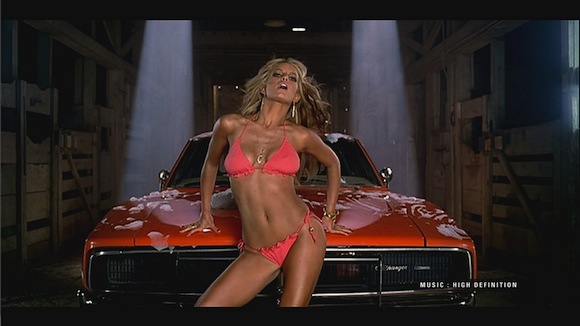
Brett Ratner, director. These Boots Are Made for Walking (2005). Still from music video for song performed by Jessica Simpson.
I Know What Boys LikeDwayne Strike, 2013
The artist's description:
I was going through ideas for this piece with a friend and I mentioned this video by Jessica Simpson where she was washing a car (These Boots Were Made for Walking). I decided to go outside to where the workers were building and stage something that would be close to that—and to other videos that incorporate the same idea of the idealized half-naked woman, washing a car that could be hers or not, under a voyeuristic gaze.Click here to view work.
I found this move—which some might write off as "loose"—more conservative than anything; the sexual liberation of women is still finding its feet while the sexual liberation of men is strictly limited to the built man with a 6-pack. Anything that transgresses this is a minority, especially the idea of role or gender reversal.
We still live in a time in which everyone wants to compartmentalize everything – especially sexuality and gender. Through my drag persona, I try to take both sides of myself (feminine and masculine) and wear them both as badges, through my actions and dress.
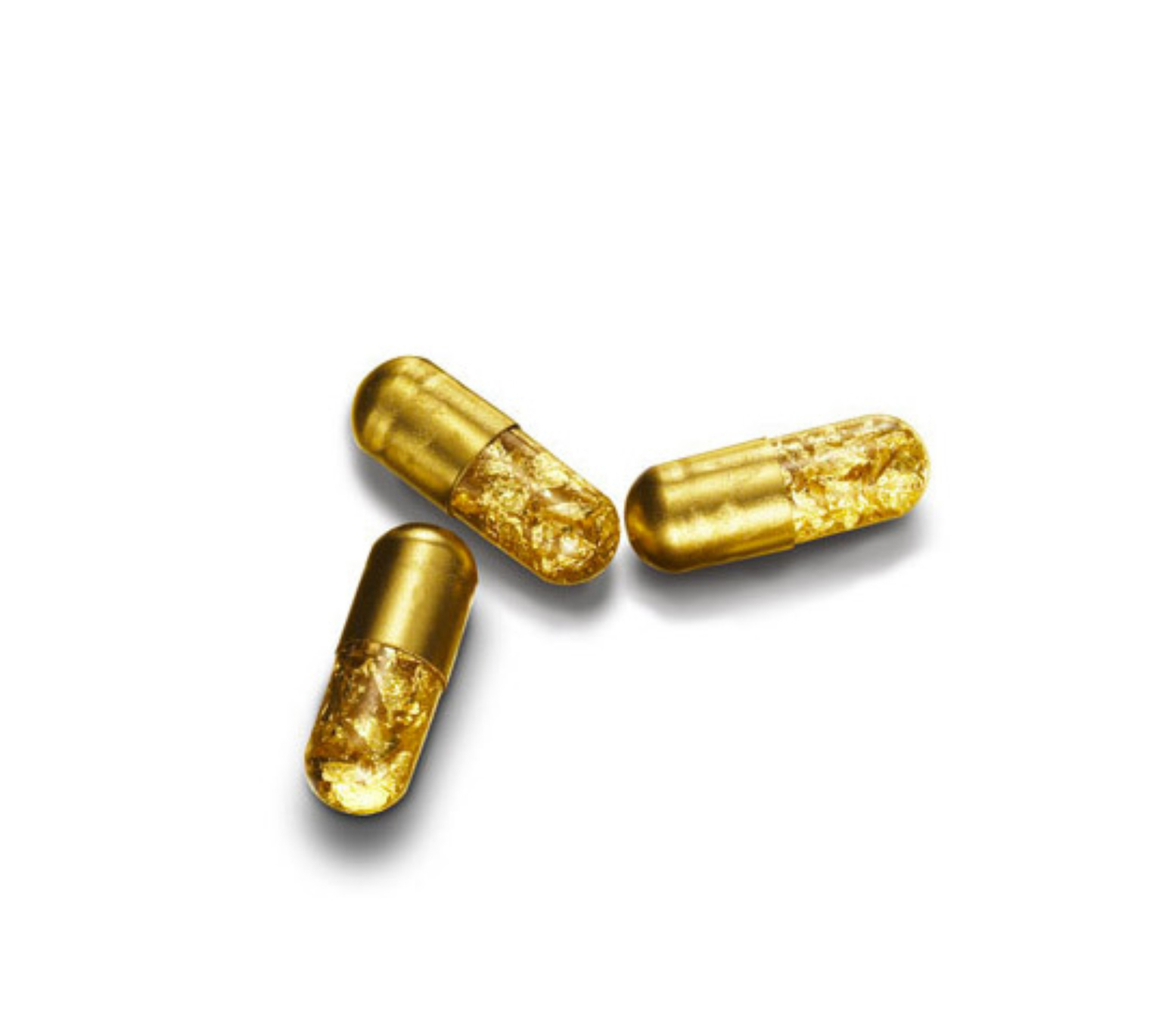
Milking It Marisa Olson, 2013
The chemical therapy the artist takes to cope with the death of a parent on chemotherapy causes the child to artificially lactate like a new mother. Here she takes matters into her own hands, deliberately "crying on command" to share a milky tear as evidence of this abject paradox.
Click here to view work (NSFW).
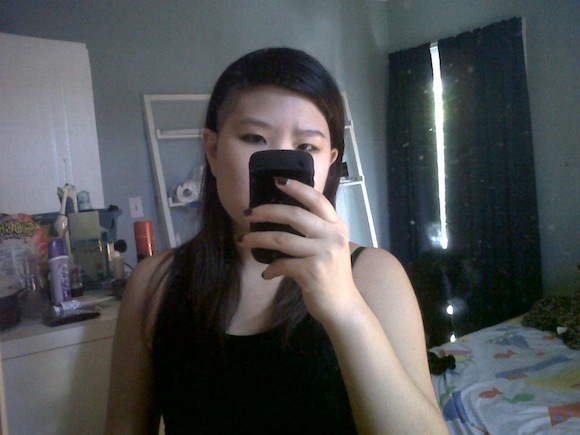
Cam Twist
ManyCam and webcam video
Jennifer Chan
Artist's statement:
"Whenever you put your body online, in some way you are in conversation with porn," writes Ann Hirsch.Click here to view artwork.
"If you do not want your image to travel somewhere far away, do not release it to the cloud," warns Jacob Ciocci.
Some women live from the neck up because they consider their bodies too horrifying to claim as their own. Conversely, some live only from the neck down because they have been told their faces and their minds do not deserve love.
We see this fear and fascination between the face and the body play out in the ubiquity of careful cropped profile pics and high-angle selfies. This is the anxiety of appearing online.
Self-portraiture is the emotional labor of young women who—through the mirrored feedback of webcam and video previews—observe themselves both as digital subject and object. They learn the accurate angles and gestures of sexy-but-not-"slutty,", bold-but-not-"bitchy" poses. At best, phone cameras and webcams provide a means to reinvent an embodied and full-bodied representation of ourselves. Yet the responses the resulting images invoke—such as online catcalls, insults and sermons—fuel an ongoing need to self-police the performance of feminine representation.
Video may be the medium of narcissism, but a narcissist does not a performer make. I hate my body and I am ok with that. I never see myself objectively. It is through a camera I see myself become not-me, or the me I cannot be.
Genevieve Belleveau:
Now we are vomiting Vines. Suffocating gardens of earthly delight incite immersive, daily make believe. Do you trim your Vine or let it grow wild? Is it adornment or is it a weed? Sign-on in #selfieaffirmation of the you we now incessantly see. When you are watching me you are consuming desire, pink paste fills your feed. In the absence of product, what do you need? Your urgency is currency, eat and release, eat and release. Perpetually purging, this need to feed, this need to feed the feed.Eat the unfold @gorgeoustaps
Click here to view work.
Image by Laura Lachman. Body Mod by Mike Mabes at The Garden Of Earthly Delights.

Image from Jessica Borusky, The Posture Grid! (2013)
Ring Around Rogue BottomCreighton Baxter, 2013
Ring Around Rogue Bottom is a queer and lonely joke actuated through a crooked game of ring-toss. The performance is a spectral type of child's play; obsessivelly rummaging through a language of trauma that employs humor, endurance and repetition. It is a no-top-needed type of situation.
Ring Around Rogue Bottom was performed within the post-performance installation of Jessica Borusky's seven-hour durational work The Posture Grid! Baxter thinks of her engagement with Borusky's performance detritus as a fragmentary moment of an evolving dialogue between the two artists; exploring points of collaboration and critical engagement with each other's artistic practices surrounding themes of sexual trauma/survival, body fascism and queer histories within the United States. Baxter and Borusky comprise one half of the creative collective The Highest Closet, with artists Sarah Hill and Hayley Morgenstern.
Click to view artwork.
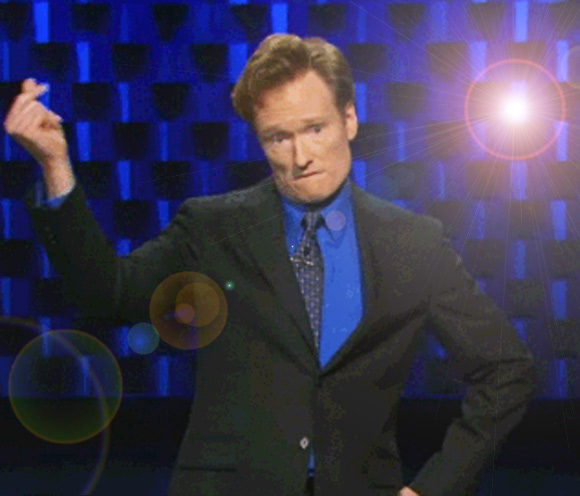
Still frame from Conan O'Brien Finger Wave (reaction GIF).
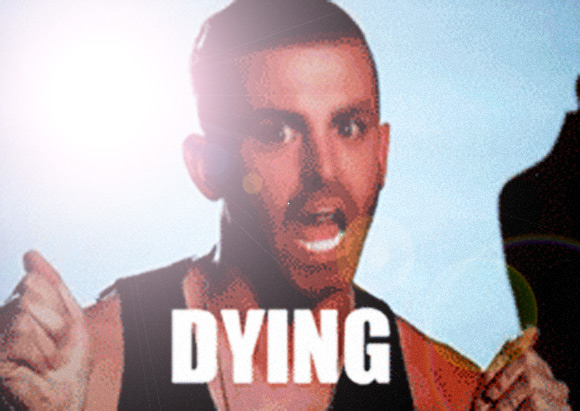
I asked Jake to mimic a bunch of reaction gifs I found online. This one turned out the best. I like functional gifs that can be injected into conversations and gossip blog comment sections. This is a gesture you can copy+paste into interactions that require sass. You can forget about this gif's brief foray into art territory. No glitch. No new media.I've often asked Jake to be in my work because he is a tragic beauty. I've never met him IRL. I like sending people directions and seeing how they execute them. It's never what I think it will be, which is the reason to do it. I don't want to have control over images. I want to have transatlantic sporadic virtual working relationships.He looks focused and slightly concerned. His accessories are sassy but he doesn't exude sass. The gesture is not backed up by the corresponding emotion. There is a distance between who you are and who you want to be. The GIF exists in the space between those things.
Click here to view work.
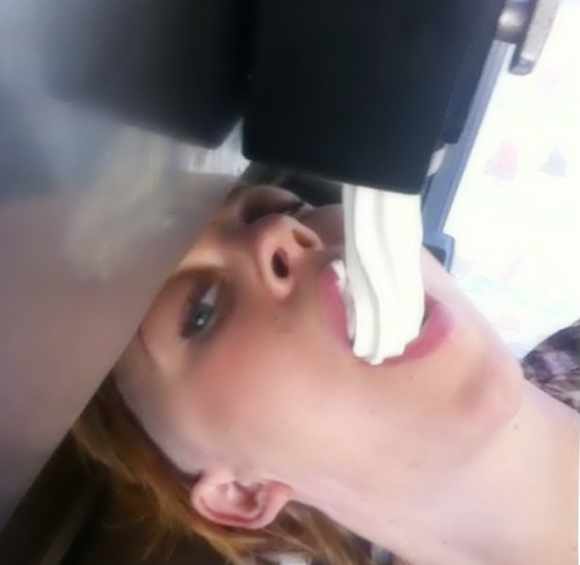
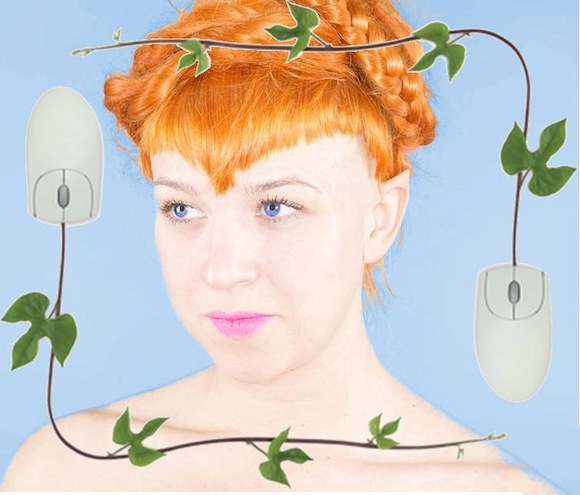
Nema komentara:
Objavi komentar